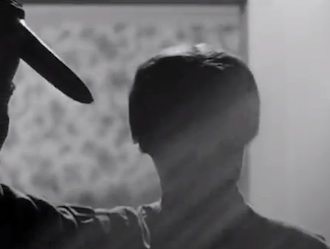What makes a Halloween film score creepy?
Turn down the volume on your favorite Halloween horror film and suddenly the movie goes from scary to silly. Why is that blonde running around a haunted house anyway – and didn’t anyone notice that weird guy with the axe?
Music shapes dramatic moments in film, pulling at our heartstrings, scaring us out of our chairs, and hitting us with powerful dramatic moments.
Use ear training and your aural skills to learn some of the key elements of Halloween horror film music. Then create your own Halloween film music at home. See our previous article to learn how you can use improvisation to compose horror film scores.
Dramatic Tension
Bernard Herrmann worked with Alfred Hitchcock on some of the suspense king’s most famous films, including Psycho and Vertigo.
Psycho
Watch the famous shower scene from Alfred Hitchcock’s film: first with the sound muted. Then watch the scene again, this time with Herrmann’s track.
Use your listening skills.
Listen to how the riveting soundtrack jumps in with the killer. Each slice of the knife seems to have a corresponding scrape of the violins. The motion of the arm matches the steady rhythm of the strings. As we watch Janet Leigh’s blood (supposedly chocolate syrup for the Halloween Hitchcock trivia fans) flow down the drain, the music takes on ominous low notes of finality. Even if we had hope, the music tells us that Leigh’s character is dead.
Halloween
Even a main title can hold dramatic tension. A famous example is John Carpenter’s theme from Halloween. A composer and musician, as well as successful horror filmmaker, Carpenter composed this theme for the first of the Halloween cult franchise.
In this case, the steady rhythm supported by ominous synth strings creates tension through use of the minor scale and low pedal tones. Repetition normally creates a sense of calmness as familiar material returns, but in this case each repetition of the mysterious musical motif leads to more dramatic tension and horror.
Creepy Instruments and Sound Effects
Right when “talkies” took over the film industry, film composers often used what is called “Mickey Mousing” in music.
When a composer “Mickey Mouses” a film, he or she writes wall-to-wall music in the style of a cheesy cartoon. Today, only animated features have that kind of continuous music and sound effects. Most films employ a combination of film music, silence, subtle sound effects, and popular music.
This fun Silly Symphony cartoon is a great example of both “Mickey Mousing”, popular Halloween sound effects, and musical examples. Your ear training and active listening skills will come in handy. Listen to how the instruments copy the action on screen, like woodblocks imitating dancing bones or a timpani glissando imitating the wind.
Can you use your ear training skills and figure out:
- What instruments are used to create a dark and scary mood?
- Which Halloween sound effects do you recognize from modern movies?
- How are classical music excerpts used?
- How are minor scales used?
By contrast, the “11.11.11” trailer shows a more modern example of film music with some of the typical musical elements you would expect to find today.
Use your ear training skills to hear:
- Dramatic orchestral and percussive hits at scene changes
- Use of whispered text
- Sound effects
- Shouting in the choir
- Electronic music elements
- Classic horror elements like a ticking clock or “beating heart” sound
- Eerie synth pad holding out a suspenseful tone
- Dissonance
When you write a Halloween track, you want to stay original – combining key horror elements without dipping into hackneyed cheesiness. Then again it depends on the project – perhaps that’s what you want to do!
As a final example, here is the video portion of a work I created a few years back, called virelaan, for the Millikin Percussion Ensemble. It was a multimedia work for percussion ensemble, tape, and video. The ghost of the “Rail Girl” haunts the Albert Taylor Theater in Decatur, Illinois, and virelaan was written in dedication to her.
In this piece, I combined classic horror elements like a ticking clock and scary church organ music with modern synthesized elements and effected ghostly vocals as a disturbing sound track to the disturbing original animation. At about 7:00 the freaky music box section starts with haunting stop motion animation, dipping back into a vortex of Halloween horror madness.
Hopefully that’s enough to inspire your own creepy creations this Halloween.
Share your scary music with us! We’d love to hear how you create freaky music in the comments below.







